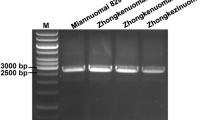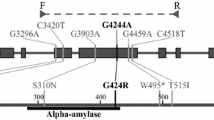Abstract
The granule-bound starch synthase(GBSS), starch branching enzymes 1 (SBE1)and 3 (SBE3) are major enzymes involved in starch biosynthesis in rice endosperm. Available sequences of Sbe1 and Sbe3 genes encoding corresponding SBE1 and SBE3 have been used to identify homologous regions from genome databases of both the indica rice 93-11 and the japonica rice Nipponbare. Sequence diversities were exploited to develop gene-tagged markers to distinguish an indica allele from a japonica allele for both Sbe1 and Sbe3 loci. With these newly developed gene-tagged markers and available Wx gene markers, the roles of these starch-synthesizing genes (Sbe1, Sbe3, and Wx) in determining amylose content (AC) in the rice endosperm were evaluated using a double-haploid (DH)population derived from a cross between the indica rice cv. Nanjing11 and the japonica rice cv. Balilla. Only the Wx and Sbe3 loci had significant effects on the AC variation. On average, indica Wx a genotypes showed ∼9.1% higher AC than japonica Wx b genotypes, while indica Sbe3 a genotypes showed ∼1.0% lower AC than japonica Sbe3 b genotypes. A significant interaction was also observed between Wx and Sbe3 loci whereby the amylose content was 0.3% higher in Sbe3 a than Sbe3 b genotypes in the presence of the Wx a allele, but it was lower by 2.3% in the presence of the Wx b allele. Overall, polymorphisms at the Wx and Sbe3 loci together could account for 79.1% of the observed AC variation in the DH population. The use of gene-tagged markers in marker-assisted selection and gene functional analysis was also discussed.
Similar content being viewed by others
References
Ayres, N.M., A.M. McClung, P.D. Larkin, H.F.J. Bligh, C.A. Jones & W.D. Park, 1997. Microsatellites and a single-nucleotide polymorphism differentiate apparent amylose classes in an extended pedigree of US rice germplasm. Theor Appl Genet 94: 773-781.
Blakeney, A., 1984. Rice grain quality. In: A. Currey (Ed.), Rice Growing in New South Wales, pp. 1-5. Department of Agriculture New South Wales and the Rice Research Committee, Yanco, Australia.
Bligh, H.F.J., P.D. Larkin, P.S. Roach, C.A. Jones, Y.H. Fu & W.D. Park, 1998. Use of alternate splice sites in granule-bound starch synthase mRNA from low-amylose rice varieties. Plant Mol Biol 38: 407-415.
Bligh, H.F.J., R.I. Till & C.A. Jones, 1995. A microsatellite sequence closely linked to the waxy gene of Oryza sativa. Euphytica 86: 83-85.
Burton, R.A., J.D. Bewley, A.M. Smith, M.K. Bhattacharyya, H. Tatge, S. Ring, V. Bull, W.D.O. Hamilton & C. Martin, 1995. Starch branching enzymes belonging to distinct enzyme families are differentially expressed during pea embryo development. Plant J 7: 3-15.
Cai, X.L., Z.Y. Wang, Y. Xing, J.L. Zhang & M.M. Hong, 1998. Aberrant splicing of intro1 leads to the heterogeneous 5'UTR and decreased expression of the waxy gene in rice cultivars of intermediate amylose content. Plant J 14: 459-465.
Guan, H.P. & J. Preiss, 1993. Differentiation of the properties of the branching isozymes from maize (Zea mays). Plant Physiol 102: 1269-1273.
Isshiki, M., K. Morino, M. Nakajima, R.O. Okagaki, S.R. Wessler, T. Izawa & K. Shimamoto, 1998. A naturally occurring functional allele of he waxy locus has a GT to TT mutation at the 5' splice site of the first intron. Plant J 15: 133-138.
James, M.G., K. Denyer & A.M. Myers, 2003. Starch synthesis in the cereal endosperm. Curr Opin Plant Biol 6: 1-8.
Juliano, B.O., 1971. A simplified assay for milled-rice amylose. Cereal Sci Today 16: 334-340.
Juliano, B.O., 1985. Criteria and tests for rice grain qualities. In: B.O. Juliano (Ed.), Rice Chemistry and Technology, pp. 443-513. American Association of Cereal Chemists, Saint Paul, Minnesota.
Larkin, P.D., A.M. McClung, N.M. Ayres & W.D. Park, 2003. The effect of the Waxy locus (Granule Bound Starch Synthase) on pasting curve characteristics in specialty rice (Oryza sativa L.). Euphytica 134: 1-11.
Liu, K.D., J. Wang, H.B. Li, C.G. Xu, A.M. Liu, X.H. Li & Q.F. Zhang, 1997. A genome-wide analysis of wide compatibility in rice and the precise location of the S5 locus in the molecular map. Theor Appl Genet 95: 809-814.
Martin, C. & A.M. Smith, 1995. Starch biosynthesis. Plant cell 7: 971-985.
Mikami, L., L.V. Dung, H.Y. Hirano & Y. Sano, 2000. Effects of the two most common Wx alleles on different genetic background in rice. Plant Breed 119: 505-508.
Mizuno, K., K. Kimura, Y. Arai, T. Kawasaki, H. Shimada & T. Baba, 1992. Starch branching enzymes from immature rice seeds. J Biochem (Tokyo) 112: 643-651.
Mizuno, K., T. Kawasaki, H. Shimada, H. Satoh, E. Kobayashi, S. Okumura, Y.</del> Arai & T. Baba, 1993. Alteration of the structural properties of starch components by the lack of an isoform of starch branching enzyme in rice seeds. J Biol Chem 286: 19084-19091.
Mizuno, K., E. Kobayashi, M. Tachibana, T. Kawasaki, T. Fujimura, K. Funane, M. Kobayashi & T. Baba, 2001. Characterization of an isoform of rice starch branching enzyme, RBE4, in developing seeds. Plant Cell Physiol 42(4): 349-357.
Okagaki, R.J. & S.R. Wessler, 1988. Comparison of non-mutant and mutant waxy genes in rice and maize. Genetics 120: 1137-1143.
Ong, M.H. & J.M.V. Blanshard, 1995. Texture determinants of cooked, parboiled rice. 2. Physicochemical properties and leaching behavior of rice. J Cer Sci 21: 261-269.
Sano, Y., M. Katsumata & K. Omura, 1986. Genetic studies of speciation in cultivated rice. Inter-and intraspecific differentiation in the waxy gene expression of rice. Euphytica 35: 1-9.
SAS Institute Inc., 2000. SAS/STAT User's Guide, Cary, NC, USA.
Sasaki, T., 2002. Rice genomics to understand rice plant as an assembly of genetic codes. Curr Sci 83: 834-839.
Smith, A.M., K. Denyer & C. Martin, 1997. The synthesis of the starch granule. Annu Rev Plant Physiol Plant Mol Biol 48: 67-87.
Takeda, Y., S. Hizukuri & B.O. Juliano, 1987. Structures of amylopectins with low and high affinities for iodine. Carbohydr Res 168: 79-89.
Tan, Y.F., J.X. Li, S.B. Yu, Y.Z. Xing, C.G. Xu & Q.F. Zhang, 1999. The three important traits for cooking and eating quality of rice grains are controlled by a single locus in an elite rice hybrid, Shanyou 63. Thero Appl Genet 99: 642-648.
Tan, Y.F. & Q.F. Zhang, 2001. Correlation of simple sequence repeat variants in the leader sequence of the waxy gene with amylose content of the grain in rice. Acta Botanica Sinica 43: 146-150.
Wang, Z.Y., F.Q. Zheng, G.Z. Shen, J.P. Gao, D.P. Snustad, M.G. Li, J.L. Zhang & M.M. Hong, 1995. The amylose content in rice endosperm is related to the post-transcriptional regulation of the waxy gene. Plant J 7: 613-622.
Yamanouchi, H. & Y. Nakamura, 1992. Organ specificity of isoforms of starch branching enzyme (Q-enzyme) in rice. Plant Cell Physiol 33: 985-991.
Author information
Authors and Affiliations
Corresponding author
Rights and permissions
About this article
Cite this article
Liu, X., Gu, M., Han, Y. et al. Developing gene-tagged molecular markers for functional analysis of starch-synthesizing genes in rice (Oryza sativa L.). Euphytica 135, 345–353 (2004). https://doi.org/10.1023/B:EUPH.0000013376.32313.15
Issue Date:
DOI: https://doi.org/10.1023/B:EUPH.0000013376.32313.15




